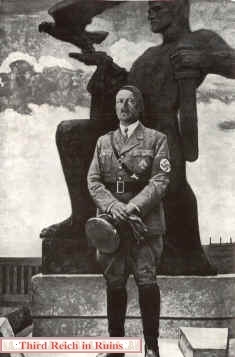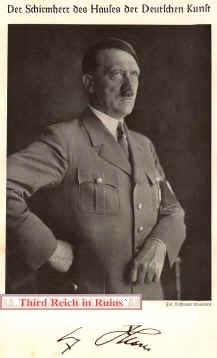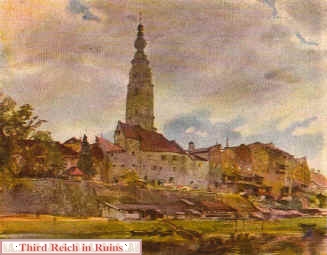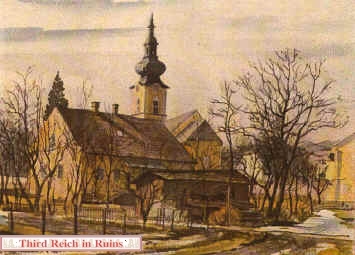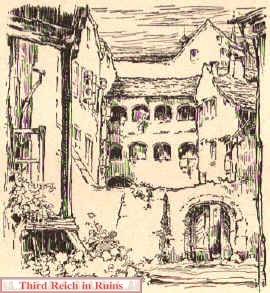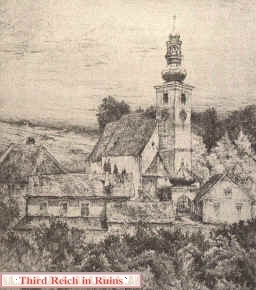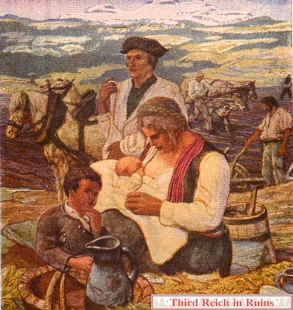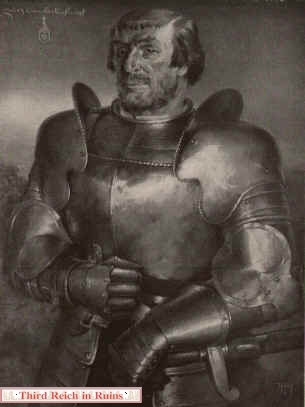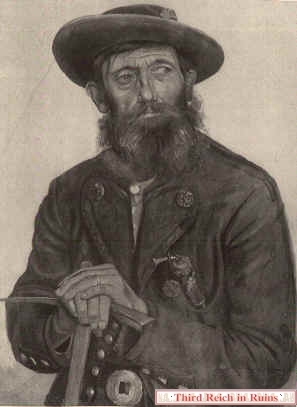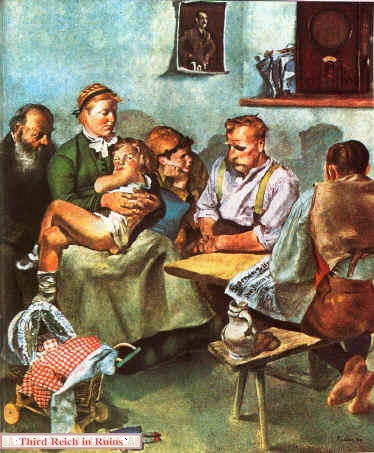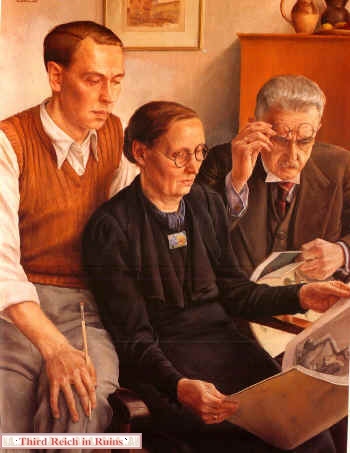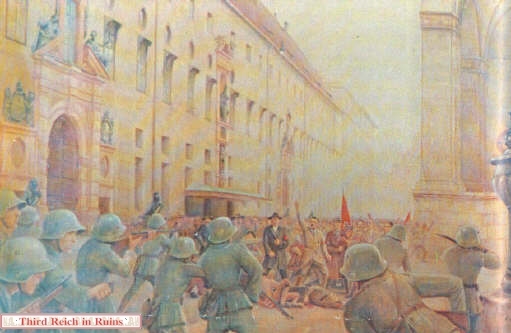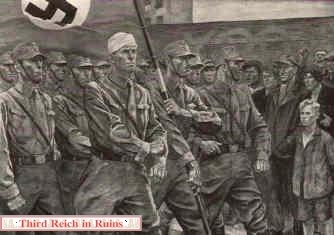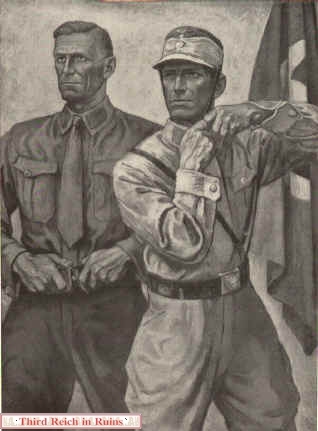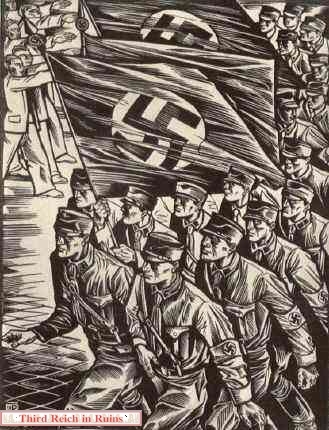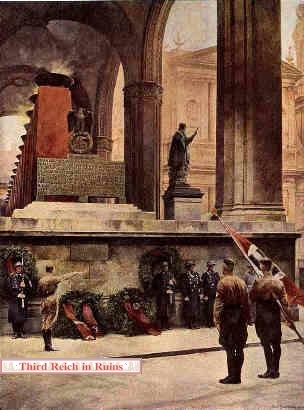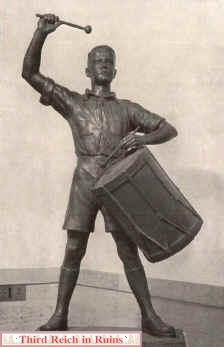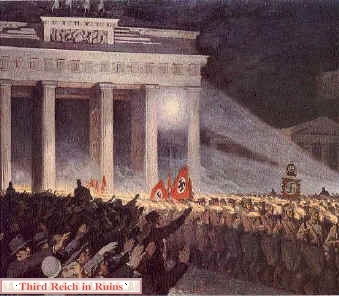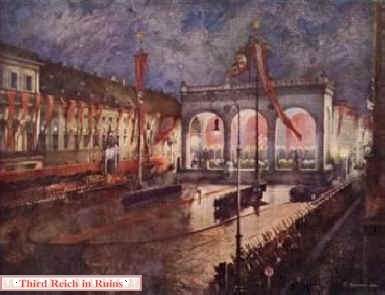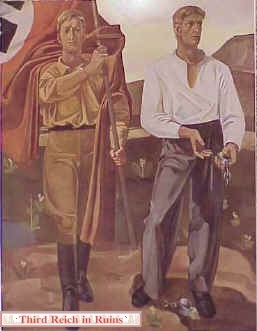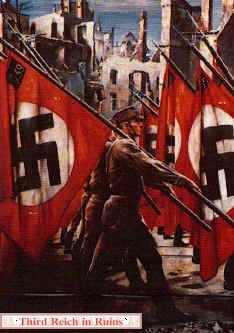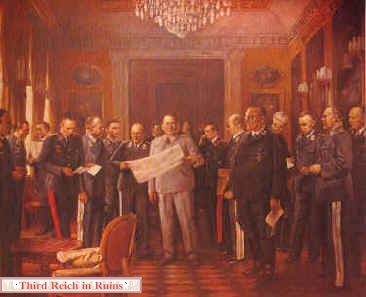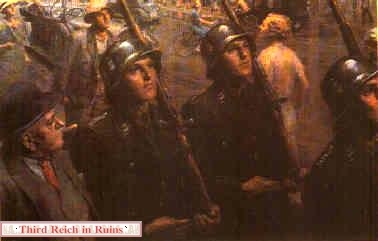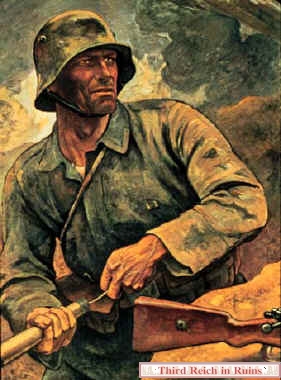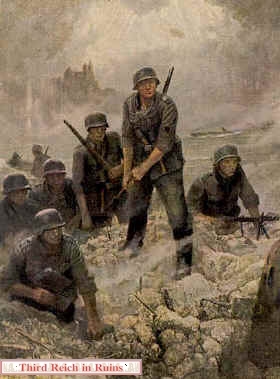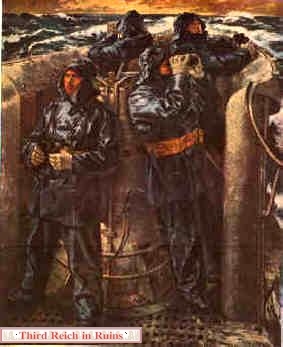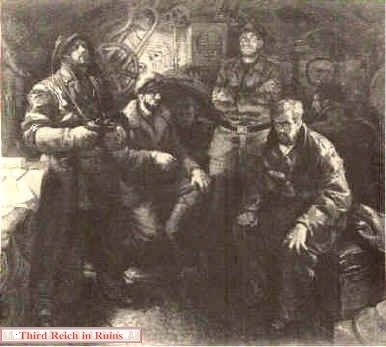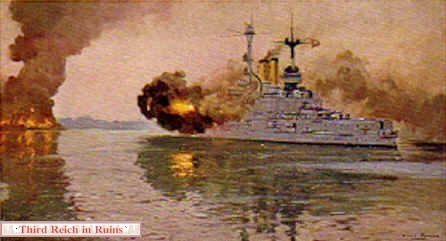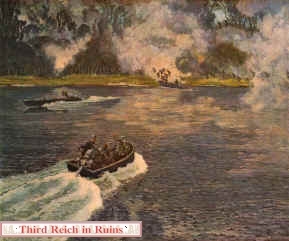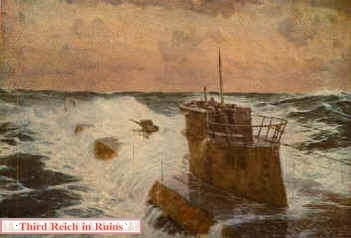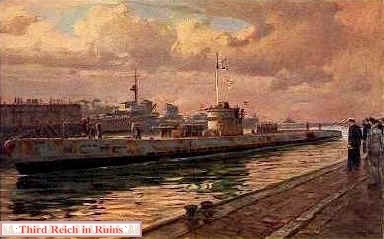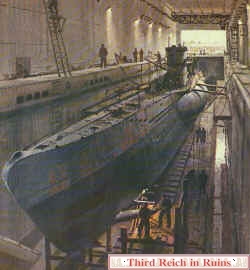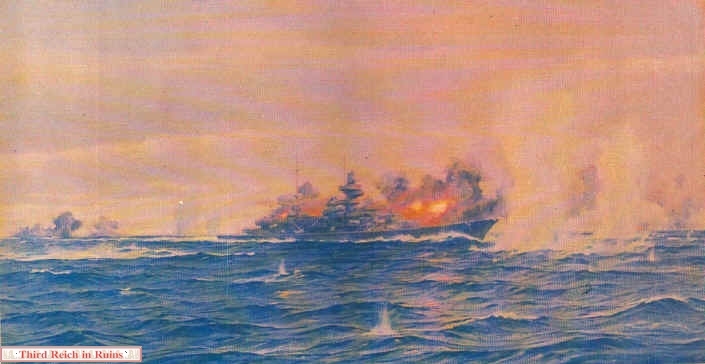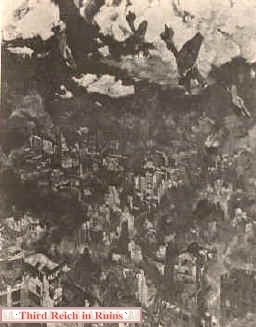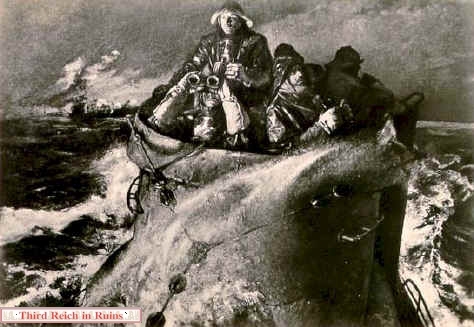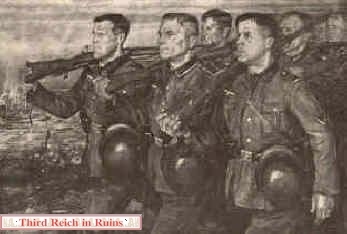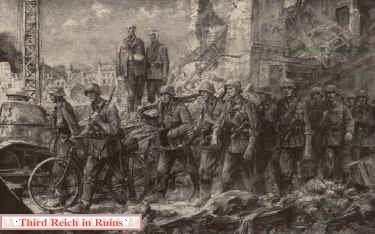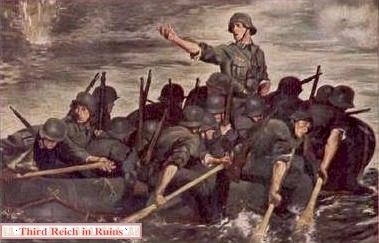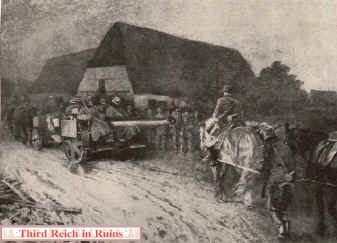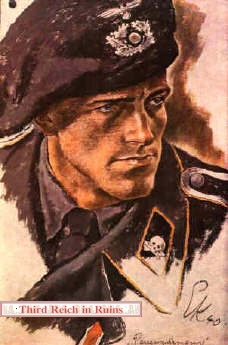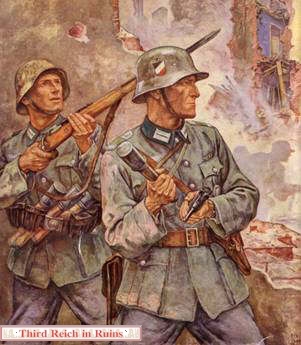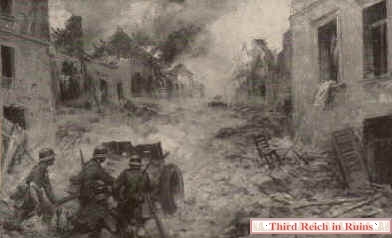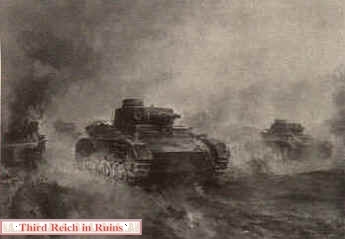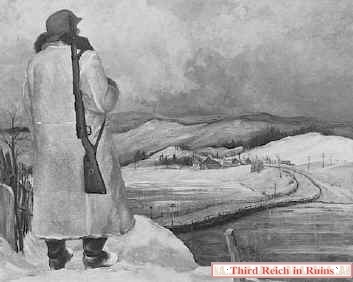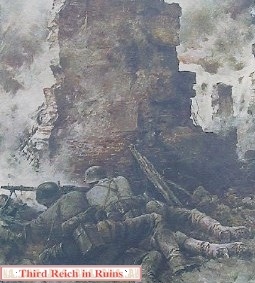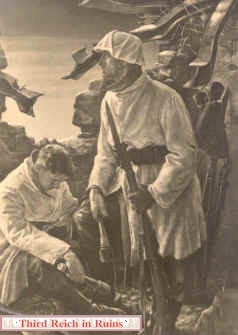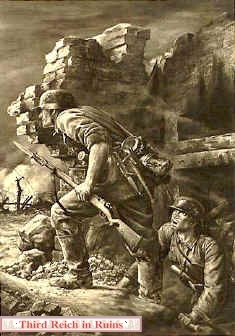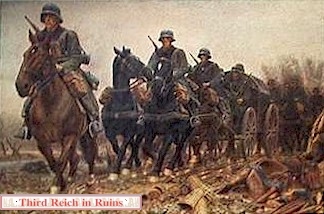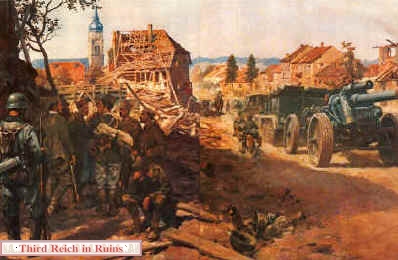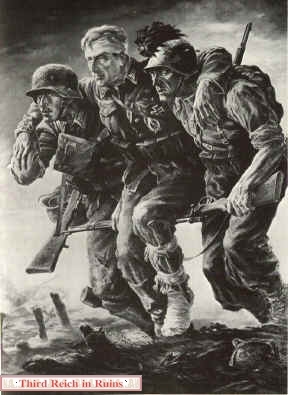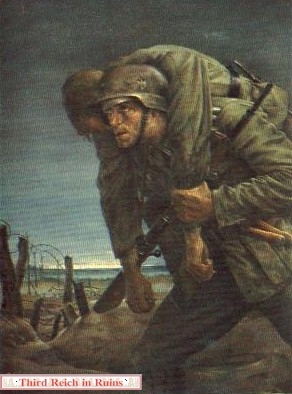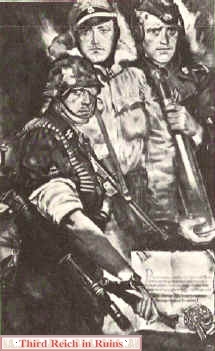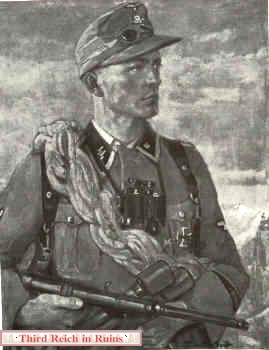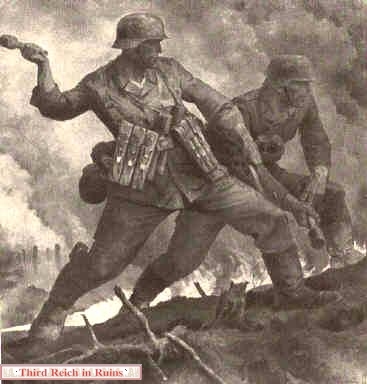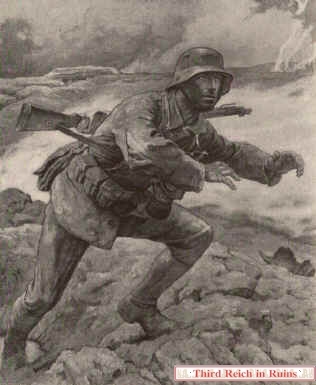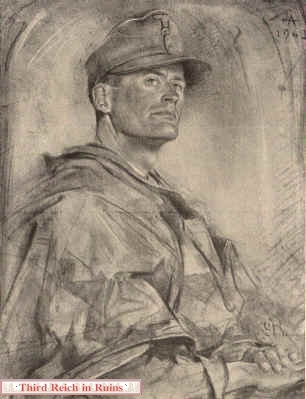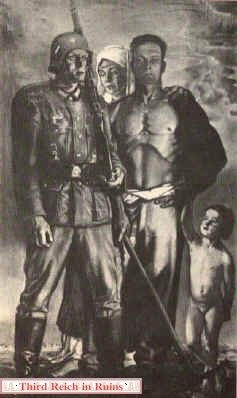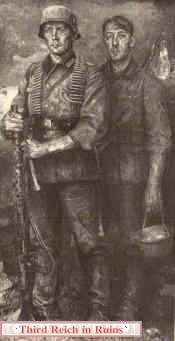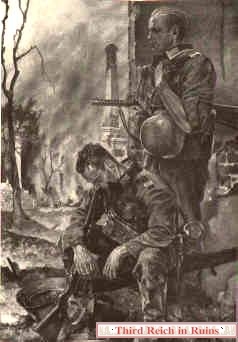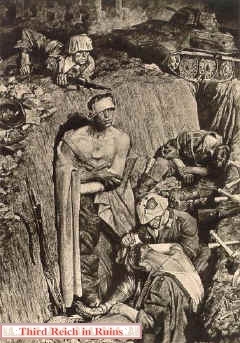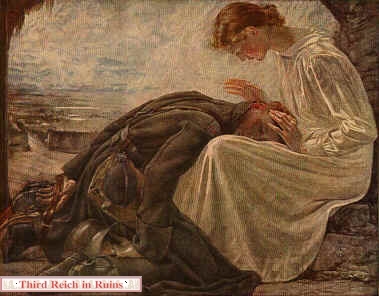تميزت فترة سيطرة حكم الحزب النازي وهتلر علي ألمانيا ... بنوع غريب من التمجيد ... للحزب النازي ... و بالذات لزعيمه هتلر ... DER FUEHRER
إنعكس ذلك علي العديد من نواحي الحياة ... ليس فقط .. الصناعة الحربية القوية ... أو الهندسة المعمارية الضخمة ذات الخطوط الواضحة ... NAZI ARCHITEKTUR ... "لاحظ الأعمدة في صورة متحف بيت الفن في ميونخ " أو الموسيقي العنيفة القوية مثلا "ريشارد واجنر" ... أو الطرق السريعة المعروفة ب AUTOBAHN ."الأوتوبان" ... أو ... أو .. أو ...
بل أنعكس ذلك ايضا علي جميع نواحي الفن والنحت والتصوير ... فكان متحف "بيت الفن" في ميونخ إلي جانب متاحف برلين ، أفضل الأماكن التي كان يعرض فيها الفن النازي
أدناه ... بعض الأمثلة ... فن رسم هتلر نفسه ... أو الحياة الألمانية
د. يحي الشاعر
اقتباس:
The annual exhibitions featured military scenes, portraits of the Führer and other Nazi leaders, German landscapes and places associated with Hitler's youth, nudes, and scenes promoting German traditions, particularly "folk-art" agricultural views. Favored artists included sculptors Josef Thorak, Arno Breker, and Fritz Klimsch, and painters Sepp Hilz, Karl Truppe, Elk Eber, Wilhelm Hempfing, Ernst Liebermann, and Adolf Ziegler. The first exhibit was in 1937, at the opening of the building, and the annual shows continued through 1944.
Many of the following illustrations come from catalogs of the annual exhibits, published by Heinrich Hoffmann and others. Other illustrations come from period postcards, based on Hoffmann's photos and art reproductions. In many cases, these illustrations are all that survive of the artwork produced during the Third Reich, many of the works themselves having been lost or destroyed (click here to read an informative article on the fates and whereabouts of some of this artwork). The American military authorities confiscated much of this art at the end of World War II. Many works were returned to Germany in the 1980s, where they remain in storage, not accessible to the general public. The U.S. Army War Art collection in Washington retains several of the confiscated works, principally those showing portraits of Hitler and other Nazi leaders, and Nazi party subjects. A very few former HDK works are in private hands today.
This page is divided into four parts: this part features portraits of the Führer and his homeland, and other approved themes, Part 2 shows portraits of other Nazi leaders and Party themes, Part 3 features artwork with military themes, and Part 4 covers sculptures.
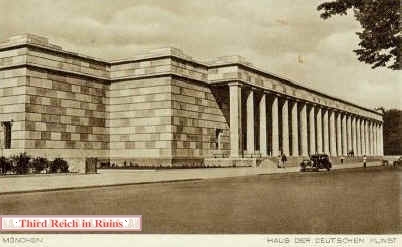
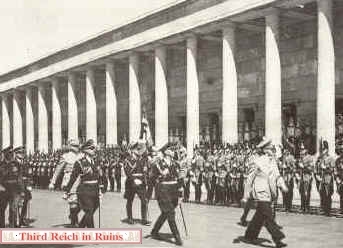
The Haus der Deutschen Kunst was built in 1933-37 to replace the Munich Art Gallery which had burned in 1931. Designed by architect Paul Ludwig Troost in the neo-classical Third Reich style, the building still serves Munich today as an art museum. (author's collection)
Hitler and Himmler inspect ceremonial troops uniformed as Bavarian infantry, at the opening of the Haus der Deutschen Kunst on July 18, 1937. (National Archives RG242)
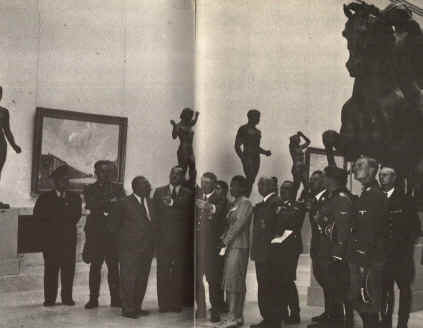
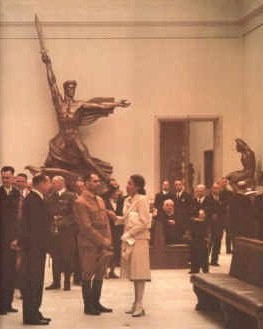
The view on the left shows the grand opening exhibition in July 1937. In the center of the photo, Hitler is seen talking to (third from the left) Heinrich Hoffmann, director Karl Kolb, and architect Paul Troost's widow Gerdy. In the background can be seen Arno Breker's "Anmut." The photo on the right shows Frau Prof. Troost talking to Rudolf Hess during the 1940 exhibit (in the background is Adolf Wamper's "Genius des Sieges" - Genius of Victory).
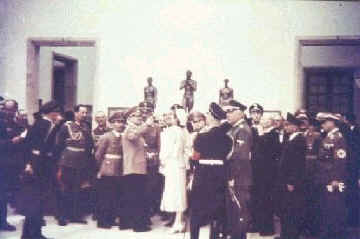
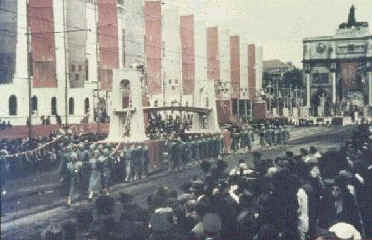 More photos of the 1937 opening exhibition. On the left, Hitler (in center) speaks with Gerdy Troost. To the left of Hitler is Josef Goebbels, and to the right of Frau Troost is Heinrich Himmler (back to camera). The photo on the right shows the parade before the exhibition opening, seen here on Ludwigstraكe, in front of the Siegestor. The parade was titled "Two Thousand Years of German Culture," and featured floats depicting scenes from German history and culture from prehistory to the present. (author's collection)
More photos of the 1937 opening exhibition. On the left, Hitler (in center) speaks with Gerdy Troost. To the left of Hitler is Josef Goebbels, and to the right of Frau Troost is Heinrich Himmler (back to camera). The photo on the right shows the parade before the exhibition opening, seen here on Ludwigstraكe, in front of the Siegestor. The parade was titled "Two Thousand Years of German Culture," and featured floats depicting scenes from German history and culture from prehistory to the present. (author's collection)
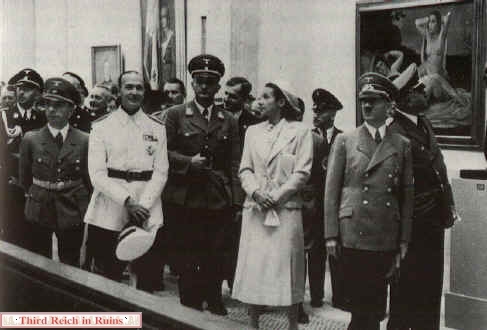
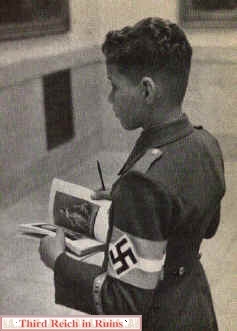
Adolf Hitler visits the 1939 exhibit opening at the HDK. Also seen in the picture are Heinrich Himmler (far left), Josef Goebbels, Dino Alfieri (Italian Ambassador), and Frau Prof. Gerdy Troost (next to Hitler). The painting in the background is Johannes Beutner's "Erwachen." (Ullstein Photo Service, Berlin)
A young member of the Hitler Jugend (Hitler Youth) visits the 1943 exhibition. He is holding the exhibition catalog open to page 65, showing Paul Scheurle's "Najade."
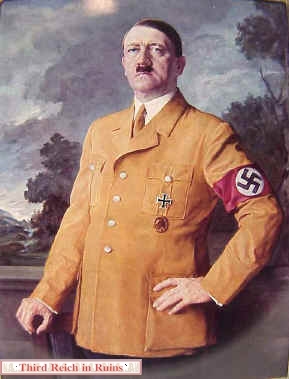

A favored theme for Third Reich artists was portraits of the Führer. These became so numerous that Hitler finally decreed that only one would be displayed "officially" at each annual Greater German Art Exhibition (although this order was not followed every year). The portrait chosen for the grand opening in 1937 was Heinrich Knirr's "Adolf Hitler, der Schِpfer des Dritten Reiches und Erneuerer der deutschen Kunst" (Hitler, the Creator of the Third Reich and Renewer of German Art - this original painting is now in the Imperial War Museum in London). The 1938 portrait was Hubert Lanzinger's allegorical "Der Bannertrنger" (The Standard Bearer), showing Hitler as an armored knight. This painting became very popular in poster and postcard form.
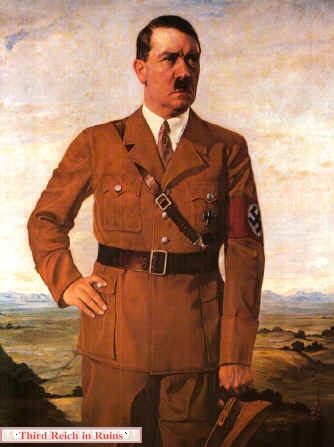

"Der Führer" by Heinrich Knirr, 1937 (this painting was later displayed in the Führerbau in Munich)
"Der Führer" by Hugo Lehmann (this portrait was based on photos taken of Hitler the night he proclaimed the establishment of the Greater German Empire, 12 March 1938, at the Rathaus in Linz, Austria)

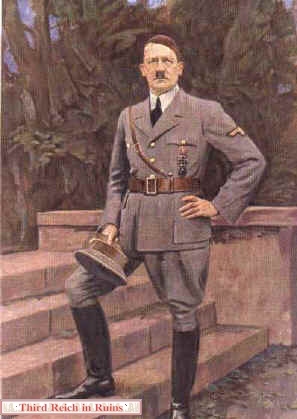
"Der Führer und Oberste Befehlshaber der Wehrmacht" by Conrad Hommel, 1940
"Bildnis des Führers" by Franz Triebsch, 1941

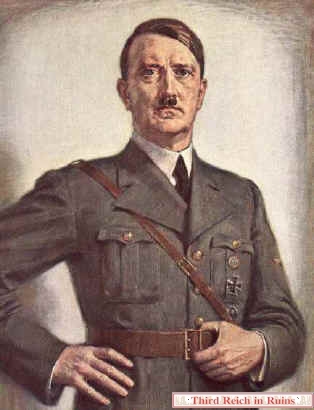
"Führerbildnis" by Hans Schachinger, 1942
"Bildnis des Führers" by Otto von Kursell, 1941
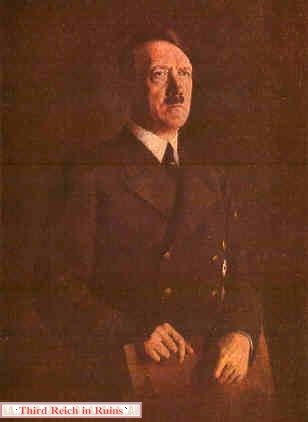
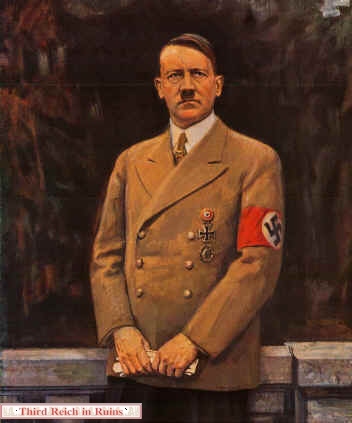
"Bildnis des Führers" by Rudolf Zill, 1942
"Bildnis des Führers" by Franz Triebsch, 1939

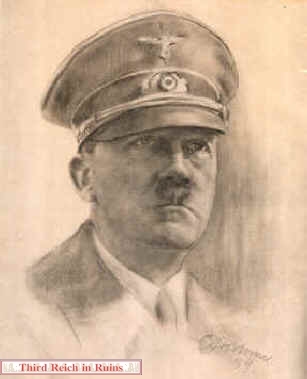
The 1943 portrait was "Der Führer" by Karl Truppe.
"Führer des Groكdeutschen Reiches" By Conrad Hommel, 1939.
إنعكس ذلك علي العديد من نواحي الحياة ... ليس فقط .. الصناعة الحربية القوية ... أو الهندسة المعمارية الضخمة ذات الخطوط الواضحة ... NAZI ARCHITEKTUR ... "لاحظ الأعمدة في صورة متحف بيت الفن في ميونخ " أو الموسيقي العنيفة القوية مثلا "ريشارد واجنر" ... أو الطرق السريعة المعروفة ب AUTOBAHN ."الأوتوبان" ... أو ... أو .. أو ...
بل أنعكس ذلك ايضا علي جميع نواحي الفن والنحت والتصوير ... فكان متحف "بيت الفن" في ميونخ إلي جانب متاحف برلين ، أفضل الأماكن التي كان يعرض فيها الفن النازي
أدناه ... بعض الأمثلة ... فن رسم هتلر نفسه ... أو الحياة الألمانية
د. يحي الشاعر
اقتباس:
Haus der Deutschen Kunst, Munich
Adolf Hitler was a genuine patron of the arts, with a love for painting and architecture, but only a patron of those arts of which he approved. Having been a painter in his youth, Hitler considered himself the supreme critic of what was, and was not, proper art. Modern "degenerate" art was definitely out. To promote "proper" art Hitler had the Haus der Deutschen Kunst (House of German Art) built in Munich, to be the scene of special yearly exhibits. Hitler placed his photographer Heinrich Hoffmann, along with director Karl Kolb, in charge of choosing the art works for these annual exhibitions.The annual exhibitions featured military scenes, portraits of the Führer and other Nazi leaders, German landscapes and places associated with Hitler's youth, nudes, and scenes promoting German traditions, particularly "folk-art" agricultural views. Favored artists included sculptors Josef Thorak, Arno Breker, and Fritz Klimsch, and painters Sepp Hilz, Karl Truppe, Elk Eber, Wilhelm Hempfing, Ernst Liebermann, and Adolf Ziegler. The first exhibit was in 1937, at the opening of the building, and the annual shows continued through 1944.
Many of the following illustrations come from catalogs of the annual exhibits, published by Heinrich Hoffmann and others. Other illustrations come from period postcards, based on Hoffmann's photos and art reproductions. In many cases, these illustrations are all that survive of the artwork produced during the Third Reich, many of the works themselves having been lost or destroyed (click here to read an informative article on the fates and whereabouts of some of this artwork). The American military authorities confiscated much of this art at the end of World War II. Many works were returned to Germany in the 1980s, where they remain in storage, not accessible to the general public. The U.S. Army War Art collection in Washington retains several of the confiscated works, principally those showing portraits of Hitler and other Nazi leaders, and Nazi party subjects. A very few former HDK works are in private hands today.
This page is divided into four parts: this part features portraits of the Führer and his homeland, and other approved themes, Part 2 shows portraits of other Nazi leaders and Party themes, Part 3 features artwork with military themes, and Part 4 covers sculptures.


The Haus der Deutschen Kunst was built in 1933-37 to replace the Munich Art Gallery which had burned in 1931. Designed by architect Paul Ludwig Troost in the neo-classical Third Reich style, the building still serves Munich today as an art museum. (author's collection)
Hitler and Himmler inspect ceremonial troops uniformed as Bavarian infantry, at the opening of the Haus der Deutschen Kunst on July 18, 1937. (National Archives RG242)


The view on the left shows the grand opening exhibition in July 1937. In the center of the photo, Hitler is seen talking to (third from the left) Heinrich Hoffmann, director Karl Kolb, and architect Paul Troost's widow Gerdy. In the background can be seen Arno Breker's "Anmut." The photo on the right shows Frau Prof. Troost talking to Rudolf Hess during the 1940 exhibit (in the background is Adolf Wamper's "Genius des Sieges" - Genius of Victory).




Adolf Hitler visits the 1939 exhibit opening at the HDK. Also seen in the picture are Heinrich Himmler (far left), Josef Goebbels, Dino Alfieri (Italian Ambassador), and Frau Prof. Gerdy Troost (next to Hitler). The painting in the background is Johannes Beutner's "Erwachen." (Ullstein Photo Service, Berlin)
A young member of the Hitler Jugend (Hitler Youth) visits the 1943 exhibition. He is holding the exhibition catalog open to page 65, showing Paul Scheurle's "Najade."


A favored theme for Third Reich artists was portraits of the Führer. These became so numerous that Hitler finally decreed that only one would be displayed "officially" at each annual Greater German Art Exhibition (although this order was not followed every year). The portrait chosen for the grand opening in 1937 was Heinrich Knirr's "Adolf Hitler, der Schِpfer des Dritten Reiches und Erneuerer der deutschen Kunst" (Hitler, the Creator of the Third Reich and Renewer of German Art - this original painting is now in the Imperial War Museum in London). The 1938 portrait was Hubert Lanzinger's allegorical "Der Bannertrنger" (The Standard Bearer), showing Hitler as an armored knight. This painting became very popular in poster and postcard form.


"Der Führer" by Heinrich Knirr, 1937 (this painting was later displayed in the Führerbau in Munich)
"Der Führer" by Hugo Lehmann (this portrait was based on photos taken of Hitler the night he proclaimed the establishment of the Greater German Empire, 12 March 1938, at the Rathaus in Linz, Austria)


"Der Führer und Oberste Befehlshaber der Wehrmacht" by Conrad Hommel, 1940
"Bildnis des Führers" by Franz Triebsch, 1941


"Führerbildnis" by Hans Schachinger, 1942
"Bildnis des Führers" by Otto von Kursell, 1941


"Bildnis des Führers" by Rudolf Zill, 1942
"Bildnis des Führers" by Franz Triebsch, 1939


The 1943 portrait was "Der Führer" by Karl Truppe.
"Führer des Groكdeutschen Reiches" By Conrad Hommel, 1939.

